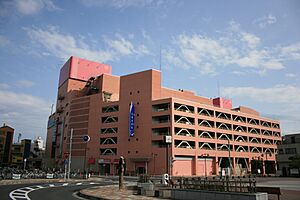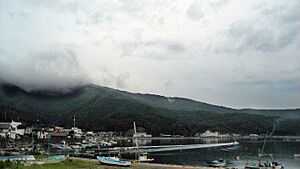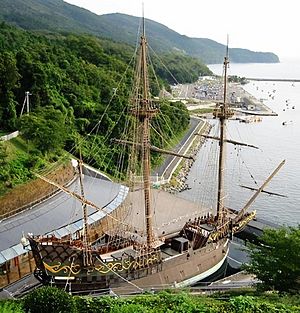Ishinomaki facts for kids
Quick facts for kids
Ishinomaki
石巻市
|
|||||||||||
|---|---|---|---|---|---|---|---|---|---|---|---|
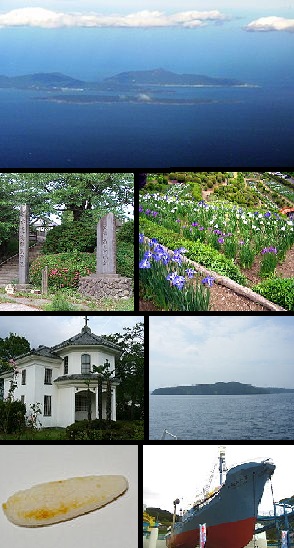
Clockwise from top: View of Mount Kinka from Ojika Peninsula, Makiyama Iris Park, Tashirojima, Ojika Whale Park, Sasa-kamaboko, Ishinomaki Saint John the Apostle Orthodox Church, Mount Hiyori
|
|||||||||||
|
|||||||||||
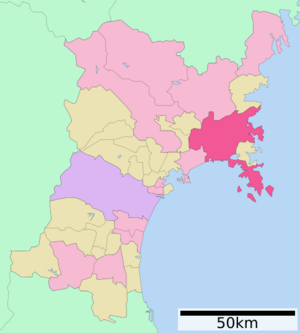
Location of Ishinomaki in Miyagi Prefecture
|
|||||||||||
| Country | Japan | ||||||||||
| Region | Tōhoku | ||||||||||
| Prefecture | Miyagi | ||||||||||
| First official recorded | 367 AD | ||||||||||
| City Settled | April 1. 1933 | ||||||||||
| Area | |||||||||||
| • Total | 554.55 km2 (214.11 sq mi) | ||||||||||
| Population
(February 2, 2022)
|
|||||||||||
| • Total | 138,538 | ||||||||||
| • Density | 249.8206/km2 (647.032/sq mi) | ||||||||||
| Time zone | UTC+09:00 (Japan Standard Time) | ||||||||||
| Phone number | 0225-95-1111 | ||||||||||
| Address | 14-1 Kokucho, Ishinomaki-shi, Miyagi-ken 986-8501 | ||||||||||
| Climate | Cfa | ||||||||||
|
|||||||||||
Ishinomaki (石巻市, Ishinomaki-shi) is a city located in Miyagi Prefecture, Japan. As of 2 February 2022[update], the city has an estimated population of 138,538, and a population density of 250 persons per km2 in 61,919 households. The total area of the city is 554.55 square kilometres (214.11 sq mi).
Contents
Geography
Ishinomaki is in northeastern Miyagi Prefecture. The city borders on Ishinomaki Bay to the south and Minamisanriku city to the north, with the Kitakami Mountains to the west. Its coastline forms part of the Sanriku Fukkō National Park, which stretches north to Aomori Prefecture. Ishinomaki includes Tashirojima (also known as "Cat Island"), Ajishima, and Kinkasan, three islands off the south coast of Oshika Peninsula.
Neighboring municipalities
Miyagi Prefecture
- Higashimatsushima
- Minamisanriku
- Misato
- Onagawa
- Tome
- Wakuya
Climate
Ishinomaki has a humid climate (Köppen climate classification Cfa) characterized by mild summers and cold winters. The average annual temperature in Ishinomaki is 11.9 °C (53.4 °F). The average annual rainfall is 1,091.3 mm (42.96 in) with September as the wettest month. The temperatures are highest on average in August, at around 23.6 °C (74.5 °F), and lowest in January, at around 1.0 °C (33.8 °F). Its record high is 36.8 °C (98.2 °F), reached on 15 August 2007, and its record low is −14.6 °C (5.7 °F), reached on 6 January 1919.
| Climate data for Ishinomaki (1991−2020 normals, extremes 1887−present) | |||||||||||||
|---|---|---|---|---|---|---|---|---|---|---|---|---|---|
| Month | Jan | Feb | Mar | Apr | May | Jun | Jul | Aug | Sep | Oct | Nov | Dec | Year |
| Record high °C (°F) | 15.2 (59.4) |
19.2 (66.6) |
20.7 (69.3) |
28.4 (83.1) |
30.7 (87.3) |
32.0 (89.6) |
35.6 (96.1) |
36.8 (98.2) |
34.0 (93.2) |
28.5 (83.3) |
23.7 (74.7) |
21.9 (71.4) |
36.8 (98.2) |
| Mean daily maximum °C (°F) | 4.8 (40.6) |
5.6 (42.1) |
8.9 (48.0) |
14.1 (57.4) |
18.7 (65.7) |
21.9 (71.4) |
25.2 (77.4) |
27.0 (80.6) |
24.2 (75.6) |
19.1 (66.4) |
13.2 (55.8) |
7.3 (45.1) |
15.8 (60.5) |
| Daily mean °C (°F) | 1.0 (33.8) |
1.6 (34.9) |
4.6 (40.3) |
9.6 (49.3) |
14.5 (58.1) |
18.3 (64.9) |
21.9 (71.4) |
23.6 (74.5) |
20.5 (68.9) |
15.0 (59.0) |
8.9 (48.0) |
3.4 (38.1) |
11.9 (53.4) |
| Mean daily minimum °C (°F) | −2.2 (28.0) |
−2.0 (28.4) |
0.5 (32.9) |
5.4 (41.7) |
11.0 (51.8) |
15.5 (59.9) |
19.5 (67.1) |
21.1 (70.0) |
17.4 (63.3) |
10.9 (51.6) |
4.6 (40.3) |
0.0 (32.0) |
8.5 (47.3) |
| Record low °C (°F) | −14.6 (5.7) |
−13.1 (8.4) |
−10.3 (13.5) |
−5.0 (23.0) |
−0.1 (31.8) |
5.7 (42.3) |
8.3 (46.9) |
11.5 (52.7) |
6.2 (43.2) |
−0.7 (30.7) |
−4.6 (23.7) |
−10.5 (13.1) |
−14.6 (5.7) |
| Average precipitation mm (inches) | 38.8 (1.53) |
31.0 (1.22) |
72.4 (2.85) |
86.1 (3.39) |
96.8 (3.81) |
110.6 (4.35) |
145.7 (5.74) |
115.8 (4.56) |
151.6 (5.97) |
137.9 (5.43) |
61.9 (2.44) |
42.8 (1.69) |
1,091.3 (42.96) |
| Average snowfall cm (inches) | 17 (6.7) |
16 (6.3) |
9 (3.5) |
1 (0.4) |
0 (0) |
0 (0) |
0 (0) |
0 (0) |
0 (0) |
0 (0) |
1 (0.4) |
8 (3.1) |
51 (20) |
| Average precipitation days (≥ 1.0 mm) | 4.6 | 4.9 | 7.3 | 8.3 | 9.0 | 9.4 | 11.8 | 9.2 | 9.8 | 8.0 | 6.1 | 5.5 | 93.9 |
| Average snowy days (≥ 1 cm) | 5.0 | 4.1 | 2.1 | 0.2 | 0 | 0 | 0 | 0 | 0 | 0 | 0.1 | 2.8 | 14.3 |
| Average relative humidity (%) | 71 | 69 | 67 | 68 | 74 | 80 | 84 | 82 | 80 | 76 | 73 | 73 | 75 |
| Mean monthly sunshine hours | 163.8 | 164.6 | 184.5 | 193.4 | 196.0 | 157.4 | 140.1 | 161.9 | 137.3 | 151.5 | 150.0 | 146.2 | 1,946.7 |
| Source: Japan Meteorological Agency | |||||||||||||
| Climate data for Monou, Ishinomaki (2011−2020 normals, extremes 2011−present) | |||||||||||||
|---|---|---|---|---|---|---|---|---|---|---|---|---|---|
| Month | Jan | Feb | Mar | Apr | May | Jun | Jul | Aug | Sep | Oct | Nov | Dec | Year |
| Record high °C (°F) | 11.9 (53.4) |
17.8 (64.0) |
23.4 (74.1) |
29.6 (85.3) |
32.1 (89.8) |
31.9 (89.4) |
35.3 (95.5) |
37.2 (99.0) |
34.1 (93.4) |
29.1 (84.4) |
22.0 (71.6) |
17.7 (63.9) |
37.2 (99.0) |
| Mean daily maximum °C (°F) | 4.7 (40.5) |
5.7 (42.3) |
10.8 (51.4) |
15.8 (60.4) |
21.4 (70.5) |
23.8 (74.8) |
27.3 (81.1) |
29.2 (84.6) |
25.7 (78.3) |
19.8 (67.6) |
13.4 (56.1) |
6.9 (44.4) |
17.0 (62.7) |
| Daily mean °C (°F) | 0.3 (32.5) |
0.9 (33.6) |
4.9 (40.8) |
9.8 (49.6) |
15.8 (60.4) |
19.3 (66.7) |
22.9 (73.2) |
24.4 (75.9) |
20.7 (69.3) |
14.4 (57.9) |
8.0 (46.4) |
2.4 (36.3) |
12.0 (53.6) |
| Mean daily minimum °C (°F) | −4.3 (24.3) |
−4.1 (24.6) |
−0.8 (30.6) |
3.7 (38.7) |
11.0 (51.8) |
15.6 (60.1) |
19.7 (67.5) |
21.1 (70.0) |
16.7 (62.1) |
9.4 (48.9) |
2.7 (36.9) |
−1.8 (28.8) |
7.4 (45.4) |
| Record low °C (°F) | −15.8 (3.6) |
−17.2 (1.0) |
−6.6 (20.1) |
−3.1 (26.4) |
3.9 (39.0) |
8.0 (46.4) |
13.3 (55.9) |
12.9 (55.2) |
6.8 (44.2) |
0.4 (32.7) |
−5.3 (22.5) |
−10.6 (12.9) |
−17.2 (1.0) |
| Average precipitation mm (inches) | 32.1 (1.26) |
25.7 (1.01) |
75.1 (2.96) |
101.0 (3.98) |
88.1 (3.47) |
92.9 (3.66) |
128.7 (5.07) |
114.9 (4.52) |
147.8 (5.82) |
141.3 (5.56) |
48.2 (1.90) |
42.7 (1.68) |
1,042.9 (41.06) |
| Average precipitation days (≥ 1.0 mm) | 5.1 | 5.8 | 6.4 | 8.7 | 9.0 | 8.6 | 10.4 | 11.0 | 10.3 | 8.3 | 6.3 | 6.4 | 96.3 |
| Source: Japan Meteorological Agency | |||||||||||||
Demographics
Per Japanese census data, the population of Ishinomaki has declined over the past 40 years.
| Historical population | ||
|---|---|---|
| Year | Pop. | ±% |
| 1920 | 102,953 | — |
| 1930 | 122,589 | +19.1% |
| 1940 | 137,327 | +12.0% |
| 1950 | 177,015 | +28.9% |
| 1960 | 180,012 | +1.7% |
| 1970 | 177,597 | −1.3% |
| 1980 | 186,094 | +4.8% |
| 1990 | 182,911 | −1.7% |
| 2000 | 174,778 | −4.4% |
| 2010 | 160,826 | −8.0% |
| 2020 | 140,151 | −12.9% |
History
The area of present-day Ishinomaki was part of ancient Mutsu Province. During the Sengoku period, the area was contested by various samurai clans before the area came under the control of the Date clan of Sendai Domain during the Edo period. The town prospered as a major port and transshipment center for coastal shipping between Edo and northern Japan. The town of Ishinomaki was established within Oshika District on June 1, 1889 with the establishment of the modern municipalities system.
The city was founded on April 1, 1933. On April 1, 2005, Ishinomaki absorbed the neighboring towns of Kahoku, Kanan, Kitakami, Monou and Ogatsu, and the town of Oshika to more than quadruple its area and add nearly 60,000 people to its population.
The town of Ogatsu is regionally famous for its inkstones and has an annual scallop festival in the summer. Ayukawa, a town in Oshika, was formerly a base for several ships in Japan's whaling fleet.
2011 earthquake, tsunami, and subsidence
Ishinomaki was among the municipalities most seriously affected by the 2011 Tōhoku earthquake and tsunami. Several tsunamis, up to about 10 metres (33 ft) high, traveled inland up to 5 kilometres (3.1 mi) from the coast. The tsunami destroyed around 80% of the 700 houses in the coastal port of Ayukawa, and the Kadonowaki neighborhood was largely leveled. Approximately 46% of the city was inundated by the tsunami. Following the tsunami, a Kamen Rider statue was found completely intact despite damage to the surrounding area; a writer for Tokyo Sports hoped that it would symbolically give hope to the survivors of the disaster.
Many public schools were completely destroyed, including Ishinomaki Okawa Elementary School (大川小学校), which lost 70 of 108 students and nine of 13 teachers and staff.
Ishinomaki is the Japanese municipality with the highest confirmed death count. As of 17 June 2011[update], a total of 3,097 deaths had been confirmed in Ishinomaki due to the tsunami, with 2,770 unaccounted for. Approximately 29,000 city residents lost their homes.
The earthquake shifted the city southeast and downward, lowering it by as much as 1.2 metres (3.9 ft) in some areas and causing it to flood twice daily at high tide. A once sandy beach in the Kadonowaki area completely disappeared and tides now reach the wall that once separated the beach from the road. Near the Mangakan Island, a walkway with benches was partially submerged in the river.
Rebuilding
Since 2011, Ishinomaki and other municipalities have been focusing on rebuilding and attracting residents back into the area. In 2019, eight years after the tragedy, Okawa Elementary School remains in ruins, as a memorial to those that were lost in the tsunami. Numerous parents who lost children due to staff errors sued the school and won in 2019.
Ishinomaki and other neighboring cities started construction on levees and large walls along the coast to protect against future tsunamis.
Economy
Ishinomaki traditionally has been a center for commercial fishing, especially for the cultivation of oysters.
Education
- Ishinomaki Senshu University
- Ishinomaki has 36 public elementary schools, 20 public junior high schools and one public high school operated by the city government, and seven public high schools operated by the Miyagi Prefectural Board of Education. The prefectural also operates one special education school for the handicapped. A private university, the Ishinomaki Senshu University, is also located in the city.
Transportation
Railway
JR East
- ■Ishinomaki Line
- Maeyachi - Kakeyama - Kanomata - Sobanokami - Ishinomaki - Rikuzen-Inai - Watanoha - Mangoku-Ura - Sawada
- ■Senseki Line(■■Senseki-Tohoku Line)
- Ishinomakiayumino - Hebita - Rikuzen-Yamashita - Ishinomaki
- ■Kesennuma Line
- Maeyachi - Wabuchi
Intercity bus
Daily scheduled intercity buses bound for the following cities, through the Sanriku Expressway, are being served from Ishinomaki Station.
- Sendai via Aeon Ishinomaki Shopping Center (Mall), by Miyakou Bus Co. Ltd., a subsidiary of Miyagi Transportation (Miyagi Kotsu) Co., Ltd.
- Shinjuku, Tokyo via Shibuya (overnight): via Sendai, operated by Miyagi Transportation (Miyagi Kotsu) Co., Ltd. and Keio Dentetsu Bus Corporation
Highways
 Sanriku Expressway (Ishinomaki-kanan, Kahoku, Monou-toyosato and Monou-tsuyama interchanges)
Sanriku Expressway (Ishinomaki-kanan, Kahoku, Monou-toyosato and Monou-tsuyama interchanges) National Route 45
National Route 45 National Route 108
National Route 108 National Route 398
National Route 398
Seaport
- Port of Ishinomaki
Local attractions
- Ishii lock
- Ishinomaki Saint John the Apostle Orthodox Church
- Ishinomori Manga Museum along with Manga Road celebrating Shotaro Ishinomori's manga legacy.
- The reed fields at the mouth of the Kitakami River at Ishinomaki is listed as one of the 100 Soundscapes of Japan by the Ministry of the Environment
- Numazu Shell Midden, a Jōmon period National Historic Site
- Saitō Garden
- San Juan Bautista, replica of a ship commissioned in 1613 by Date Masamune to transport an embassy to the Pope in Rome.
Sister cities
Ishinomaki is twinned with:
Friendship cities
 Civitavecchia, Italy
Civitavecchia, Italy Hagi, Japan
Hagi, Japan Kahoku, Japan
Kahoku, Japan Wenzhou, China
Wenzhou, China
Noted people from Ishinomaki
- Jun Azumi, politician
- Kasugafuji Akihiro, sumo wrestler
- Tatsuji Fuse, lawyer, social activist
- Sukekiyo Kameyama, voice actor
- Isamu Kosugi, actor, movie director
- Mai Mukaida, make-up artist and businesswoman
- Naoya Shiga, author
- Keiko Suzuka, actress
- Mayo Suzukaze, actress
See also
 In Spanish: Ishinomaki para niños
In Spanish: Ishinomaki para niños





